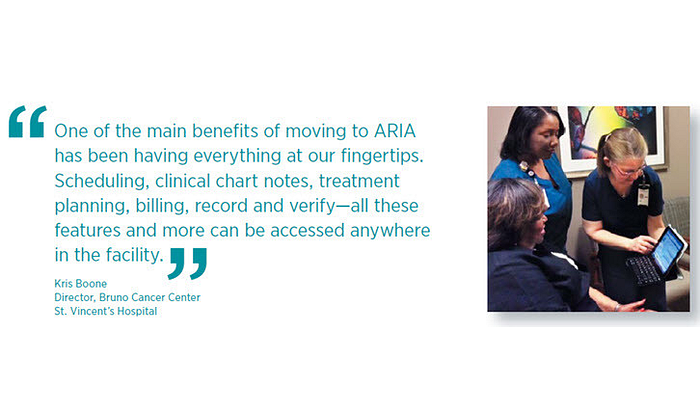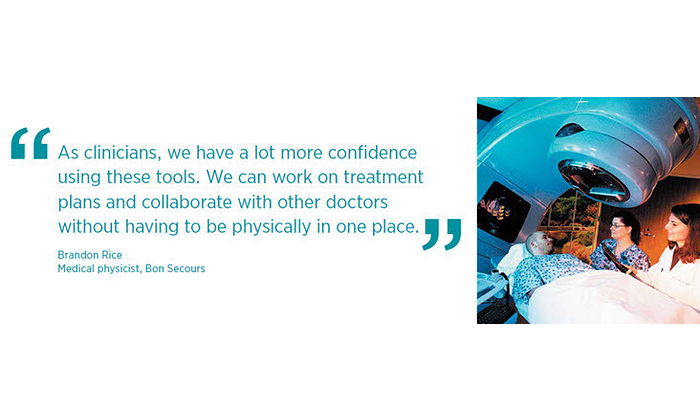Faced with the rapid evolution of digitized information, cancer treatment centers around the world are making increasingly important decisions about deploying oncology software that helps manage the patient’s entire journey— from diagnosis through follow-up. Comprehensive oncology software that provides a seamless and efficient workflow based on accurate, timely information is an essential foundation to help ensure patient safety and well-being. Increasingly, cancer centers are standardizing on the ARIA® oncology information system (OIS) to enhance multidisciplinary collaboration, streamline workflow, help improve safety procedures, and deploy the newest technologies.
For Kris Boone, director at the Bruno Cancer Center at St. Vincent’s Hospital in Birmingham, Alabama, the main driver for switching to ARIA from Elekta’s MOSAIQ® OIS was to get consistent support and expertise from one vendor on an integrated platform that incorporates the linear accelerator, treatment planning system, and OIS. The Bruno Cancer Center treats an average of 40 patients a day and had recently acquired a TrueBeam® system for image-guided radiotherapy and radiosurgery. When the cancer center moved to a nearby building and installed TrueBeam, it was an ideal time to switch to ARIA. “

"One of the main benefits of moving to ARIA has been having everything at our fingertips,” Boone says. “Scheduling, clinical chart notes, treatment planning, billing, record and verify— all these features and more can be accessed anywhere in the facility."
Full integration and on-demand accessibility
A multidisciplinary conference of physicians reviews virtually every new cancer diagnosis at St. Vincent’s. On-site medical and radiation oncologists collaborate with surgeons, primary care, and other physician consultants who may be located in other areas of the hospital. Patients and physicians are involved in a dynamic process that organizes and implements all elements of treatment.
“Our physicians and care specialists are using iPads that can access the relevant patient data from anywhere in the facility as they consult with patients, review records, and prescribe treatment,” Boone explains. “We’re even using Apple TV to bring images up on big screens in a collaborative environment. These capabilities are essential to supporting our emphasis on a multidisciplinary team approach to care that integrates the services of physicians, nurses, hospital support programs, home services, administrative staff, and more.”
The cancer center uses Eclipse™ software for treatment planning, which is fully integrated with ARIA to give appropriate staff members easy access to all aspects of patient care. Treatment planning steps are managed in ARIA through a task-driven process that maps out actions and responsibilities, and the system is set up to send alerts when a task is due.
“While everything in the building was new, from phones to complex treatment machines, the transition to ARIA went smoothly,” says Boone. “Honestly, I have rarely experienced such a smooth transition. There are usually some issues going from one system to another, but Varian experts worked closely with us to guide us through the process and make sure everyone knew what to expect.”
Excellent project management—the key to a successful transition
The success of the transition, Boone explains, was also due to excellent project management that ensured all steps were followed, everything was in place at the right time, and all medical and administrative personnel were adequately trained. “We coordinated all on-site and off-site training before going live,” says Boone. “We started early to train everyone on the screens, and selected leaders to learn and then train others— everyone from the receptionists to the physicists.”
Today, ARIA is being used by about 30 staff members every day. “Everyone is pleased with the switch to ARIA,” says Boone. “They’re finding it a lot more user friendly than the previous system, and we’re getting closer to the full elimination of paper documents. We’re using a lot more of the built-in features in ARIA than in our previous system, and that’s helping us all become more efficient.”

For Teresa Crist, director of radiation oncology at Bon Secours Health System in Virginia, consolidating with one vendor was also a major factor in deciding to switch the fivesite hospital system from its previous multi-vendor arrangement to exclusive use of ARIA. Bon Secours Virginia is part of an East-Coast not-for-profit Catholic health system, with five cancer care facilities in the state of Virginia. Two of the facilities are in the eastern portion of the state, and three in the middle. Combined, these centers treat a wide variety of cancers, and a total of about 140 patients per day.
“Moving data between facilities didn’t always work well due to the complexity of the software, the treatment planning process, and the equipment,” Crist says. “So we set up an open bid process that included all medical and administrative roles involved in the treatment process, as well as IT and finance, and assessed the proposals based on requirements. Across the board, 100 percent of the vote was to go with ARIA.”
Varian expertise guides step-by-step approach
As the cancer centers were also upgrading their treatment equipment to standardize on Varian linear accelerators, Bon Secours decided to stage the transition to ARIA across the mixed environments. The two eastern facilities went live with ARIA first, followed by the three facilities around Richmond in a step-by-step approach to address the major aspects of the transition—hardware, security, network, software, and enduser training. Depending on the task, much of the transition work was performed in parallel to save time.
“Our biggest challenge was moving medical records data from multiple systems—billing, lab, records, and so on—into ARIA,” explains Doug Brennan, head of IT at Bon Secours. “The IT team had to ensure each interface was synchronized and working smoothly, but the Varian project manager kept everyone on task, and the Varian engineers gave us the answers we needed quickly, meeting with us whenever necessary to ensure each step was completed without issue.”
Following best practices and tips from other sites that had implemented ARIA (see Centerline June 2014 edition), Crist and her team identified champions throughout the health system to be involved from the project’s early stages and during each step of the transition process. Thanks to this careful planning, and lots of upfront training, Crist says, the hospital was able to treat all patients on a completely new system from one day to the next.
“We had Varian trainers at all locations for a few days,” Crist explains. “My goal was to ensure adequate training across the board, and to allow staff the flexibility to come back once they’ve started using the equipment and ask more questions if necessary.”
Feature-rich system supports collaboration
The Bon Secours cancer centers now have full integration with Eclipse treatment planning as well. Prior to adopting ARIA, clinicians had to export patient images and other data from one system to another. Now the process is simple and saves valuable time in treatment planning per patient, transferring information across departments and reviewing images.
“As clinicians, we have a lot more confidence using these tools,” says Bon Secours medical physicist, Brandon Rice. “We can work on treatment plans and collaborate with other doctors without having to be physically in one place. This is particularly helpful if one doctor needs to cover for another at the last minute.” Rice also uses the offline image review capability in ARIA. MV, kV, and cone-beam CT images taken during treatment are available in Offline Review for comparison with reference images. Using the offline review tools, the clinician can determine if patient positioning changes are required, and then send couch-shift instructions back to the therapist.

Lisa Tuzzo, department manager of radiation oncology at Bon Secours, saw a dramatic improvement in her workflow following the transition to ARIA. “Patient administration was a long process beforehand, with patient notes in one system, scheduling in another, and so on,” she says. “Now the dosimetry team can access everything from any computer, and go from one task to another very easily—patient notes to a billing dialogue box, for instance. It’s so much easier to work with just one system.”
“ARIA provides structure, but also flexibility to customize fields according to how each group at each facility works,” Crist says. “The customizable home page means I can see the workload of all my doctors on one screen and see a summary of case progression—without having to go down in the weeds. We have five departments, and each does things slightly differently, but ARIA has helped us establish good patterns and ways of working going forward.”
In addition to user personalization, expedited workflow management, and enhanced automation, ARIA also supports the U.S. government’s ARRA and HITECH initiatives as well as other regulatory compliance mandates—key drivers for many facilities looking to successfully implement electronic health records (EHR) systems and other health information technology. For Bon Secours, this was yet another benefit of switching to ARIA. “Prior to Varian, we had no capacity to work toward achieving the meaningful use regulations,” says Crist. “The education Varian provided us has been very beneficial in supporting this.”
Julie Jervis is a freelance science writer.